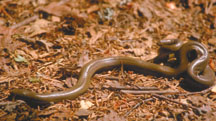|
Habitat Atlas for Wildlife at Risk
Rubber Boa
Charina bottae utahensis

Rubber
Boa
|

- Other Name: Pacific Rubber Snake.
- Slender, medium-sized snake 40 to 75 cm in length.
- Back and sides uniformly greyish- or yellowish-brown;
underside light yellow, except the throat which
may be clouded with grey.
- Head is rounded, blunt and not distinct from the
neck; plates on top of head large and irregular.
- Tail is very short, nearly as blunt as the head
and ends in a large, conical plate or scale.
Status:
British Columbia Blue List
Special Significance
Rubber Boas occur in relatively low density over most
of their British Columbia range. This burrowing, nocturnal snake
is not commonly observed and many aspects of its life history remain
poorly understood. Further research on their life history is needed
to develop management plans. Habitat degradation through forestry
and urban development has likely caused population decline. Rubber
Boas are protected under the British Columbia Wildlife Act. However,
snakes in general are often considered undesirable animals and are
killed for no apparent reason.
Distribution
- In British Columbia, found in southeastern areas including Shuswap,
Kamloops District and the Okanagan-Similkameen
valleys; also found in the Lower Fraser, Thompson, Columbia and
Kootenay valleys.
- Found nowhere else in Canada.
Habitat
- Rubber Boas forage in coniferous forests, rocky slopes, and riparian
areas.
- Coarse woody debris appears to be an important habitat
requirement.
- Rock outcrops provide suitable hibernating, nesting
and basking sites.
- Snakes hibernate and retreat to rock fissures, rodent
burrows, stumps, decaying logs, hollow trees,
beneath rocks, loose bark, leaf litter or loose, moist
soil.
- Foraging habitat is usually near a water source.
Reproduction
- Mating occurs during April or May, shortly after emergence from
hibernation.
- Pregnant females may gather together in order to maintain
a warm, stable body temperature.
- Females give birth to 2 to 8 (commonly 3 to 4) live
young in the late summer or fall.
- Snakes return to dens in the autumn.
Food Habits
- Prey includes small rodents, shrews, birds, salamanders, snakes and
other small animals which Rubber Boas suffocate in their constricting
coils.
Interesting Facts
- Appears to be one of British Columbia's most cold-tolerant snake.
- Rubber Boas are accomplished burrowers, good swimmers
and climbers; they can use their tails to grasp
as they climb shrubs and small trees.
- When alarmed, the Rubber Boa may roll itself into a
ball, concealing its head and raising its tail;
the tail can easily be mistaken for the head and for this reason
it is sometimes called
the 'Two-headed snake'.
- Both males and females possess a small spur on each
side of the vent (genital opening); these spurs
are rudimentary hind limbs and are characteristic of the boa family.
Encounters
- Rubber Boas are not poisonous, and pose no threat to humans.
- Remember - snakes will leave you alone, if you leave
them alone.
Threats
- Extensive land development in the Okanagan has
eliminated or fragmented their habitat
(including dens and feeding grounds).
- Logging practices are presumably affecting Rubber
Boas, particularly when coarse woody debris
is not retained.
- Humans unintentionally kill snakes on roadways,
but often intentionally kill snakes due to
fear.
- Snakes may be vulnerable to collection for the
pet trade due to their sluggish behaviour.
Management Considerations
- Identify and protect dens, nesting sites and
migration routes whenever possible.
- Leave 1 km buffer zone around known migration
routes and critical habitats.
- Avoid road construction near known snake dispersal
routes.
- Avoid disturbing rocks, woody debris, and rotten
logs, in forested habitats.
- Support programs that increase awareness of snakes
and their role in the ecosystem.
- Maintain good range condition in grasslands for
cover and habitat for prey species.
|
References
1. Nussbaum, R.A., E. Brodie and R. Storm. 1983. Amphibians and reptiles
of the Pacific Northwest. University of Idaho Press, Moscow, Idaho.
2. Gregory, P.T. and R.W. Campbell. 1984. The reptiles
of British Columbia. British Columbia Provincial Museum Handbook No.
44. Victoria, BC.
3. Behler, J.L. and F.W. King. 1997. National Audubon
Society: Field guide to North American reptiles and amphibians. Chanticleer
Press, Inc., New York.
|